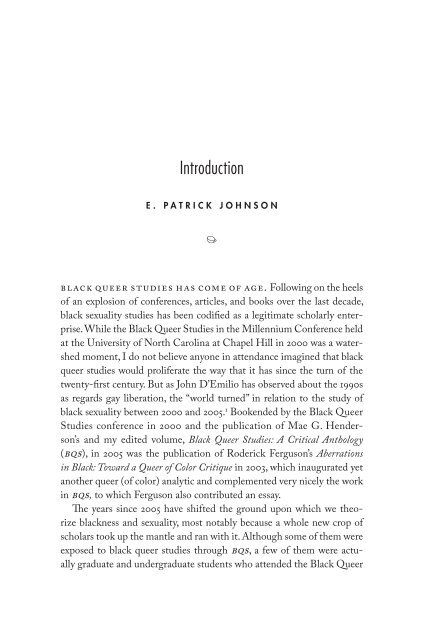No Tea
89AS6wvrf
89AS6wvrf
Create successful ePaper yourself
Turn your PDF publications into a flip-book with our unique Google optimized e-Paper software.
Introduction<br />
E. PATRICK JOHNSON<br />
black queer studies has come of age. Following on the heels<br />
of an explosion of conferences, articles, and books over the last de cade,<br />
black sexuality studies has been codified as a legitimate scholarly enterprise.<br />
While the Black Queer Studies in the Millennium Conference held<br />
at the University of <strong>No</strong>rth Carolina at Chapel Hill in 2000 was a watershed<br />
moment, I do not believe anyone in attendance imagined that black<br />
queer studies would proliferate the way that it has since the turn of the<br />
twenty- first century. But as John D’Emilio has observed about the 1990s<br />
as regards gay liberation, the “world turned” in relation to the study of<br />
black sexuality between 2000 and 2005. 1 Bookended by the Black Queer<br />
Studies conference in 2000 and the publication of Mae G. Henderson’s<br />
and my edited volume, Black Queer Studies: A Critical Anthology<br />
(bqs), in 2005 was the publication of Roderick Ferguson’s Aberrations<br />
in Black: Toward a Queer of Color Critique in 2003, which inaugurated yet<br />
another queer (of color) analytic and complemented very nicely the work<br />
in bqs, to which Ferguson also contributed an essay.<br />
The years since 2005 have shifted the ground upon which we theorize<br />
blackness and sexuality, most notably because a whole new crop of<br />
scholars took up the mantle and ran with it. Although some of them were<br />
exposed to black queer studies through bqs, a few of them were actually<br />
gradu ate and undergraduate students who attended the Black Queer


